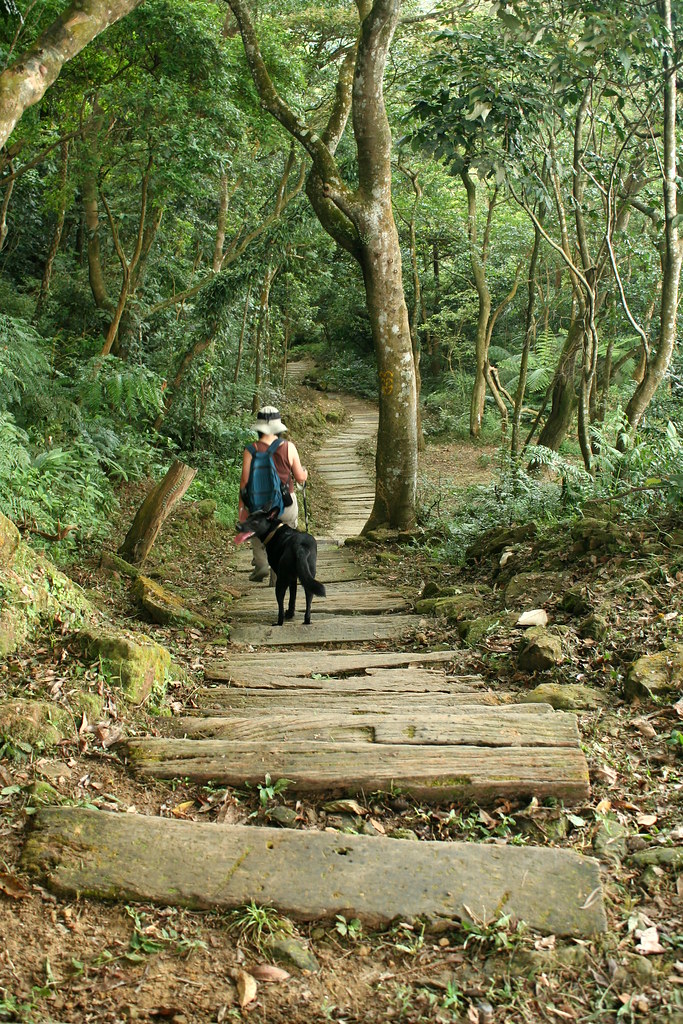
Here's something easy to test the blog waters again. A hike in the hills of Maokong, the tea growing region I am looking out at from my study window even as I type this:

A bit of background:
"Maokong in fact has quite a sweeping history. Originally it was a hunting ground for members of the Atayal indigenous tribe, Chiu said. When the Han Chinese began populating and developing the area, they brought with them a variety of industries. Development of the Maokong area dates back to the Qing Dynasty. The area was known for many different things over the years, including camphor, leeks, rice, Paochung tea, and especially Anhsi tea. After a port was opened in northern Taiwan and trading establishments were created, the area became best known for its tea leaves and its camphor.
During the period of Japanese occupation of the island, the Japanese changed the key industries in Maokong in order to meet the needs of Japan. For example, a tea production and sales organization was set up. In addition, the area became a center for indigo dye and also camphor. The Japanese also began mining the area for coal. After the outbreak of World War II, the Japanese called for the end to planting tea in the area and instead ordered the growing of rice. This had an enormous impact on the industrial make-up of Maokong. Chang Na-miao, an individual in the private sector, decided on his own to import Iron Guanyin tea, which over the years was what Maokong became associated with.
Chiu Yung-chun said that after Retrocession, the tea industry once again gradually took hold on Maokong. In 1987, when former President Lee Teng-hui was still in his position as the mayor of Taipei, he promoted the establishment of tourist tea plantations in Mucha."
Despite the couple hundred years of development it's mostly a jungle up there, and a remarkably dense one just at the doorstep of Taipei. One Sunday in August we rode up to Sanxuan Temple at the end of the gondola line (not running at the moment). A set of stairs beside the temple leads to a wonderful network of trails, much of it running along a ridgeline that extends to the coast.
We started up the stairs but then quickly took a right side path through the tea fields. In the dense forest above us we heard dozens of Muller's Barbet chattering away (pic from wikipedia).

A number of massive old tombs looked out over the city.

Not far along we found a couple wax apple trees overloaded with overripe fruit and snagged some for lunch. On the other side of a gully we picked up a main trail and followed it to an obvious junction on the backside of the ridgeline I mentioned above (it was at its lowest point here). It's a pretty area of terraced tea fields and open views. We headed down a dirt path and swung round the contours of the slopes passing a small farmhouse with a lotus pond.
I can't believe I forgot to take a pic of the farmhouse. Not only does it have a great rustic charm, but more importantly it's where I have always planned to hide out when the Chinese invade. Next time.
The section of trail past the farmhouse has been a favorite for years. I find it pretty, peaceful and full of simple charms.

After reaching a pass, the trail dropped into a narrow valley through which flows a small clean stream. The stream has a classic feel to it, but is a bit odd in this region as there are no eroded stones in the bed. I'll let my friend Richard Saunders explain this:
"Ever wondered where Maokong, that ever-popular hillside on the southern edge of Taipei where everyone goes to drink tea, got its name? Despite having the character for 'cat' in the name, it has nothing whatsoever to do with our feline friends.
Instead it's a transliteration of the Taiwanese name, 'Niaokeng,' ('teapot hole'), an allusion to the many potholes eroded into the rock of the riverbed in the valley below. For many years this fascinating sight was visited by few visitors to the area other than local geologists, but now the potholes are easy to get to, thanks to a new, well signposted path that begins not far from the upper station of the Maokong Gondola (forecast to reopen for Chinese New Year 2010).
Potholes (otherwise known as kettle holes or giant's kettles) occur when small stones or gravel, spun in a circular motion by eddies in the water, gradually erode smooth-sided, circular depressions in a stream or riverbed. These examples at Muzha might not look especially big or impressive, but they're of great interest to geologists, as they're quite uncommon."
Here's a pic of a large section of teapot holes on the Keelung River near Shifen.
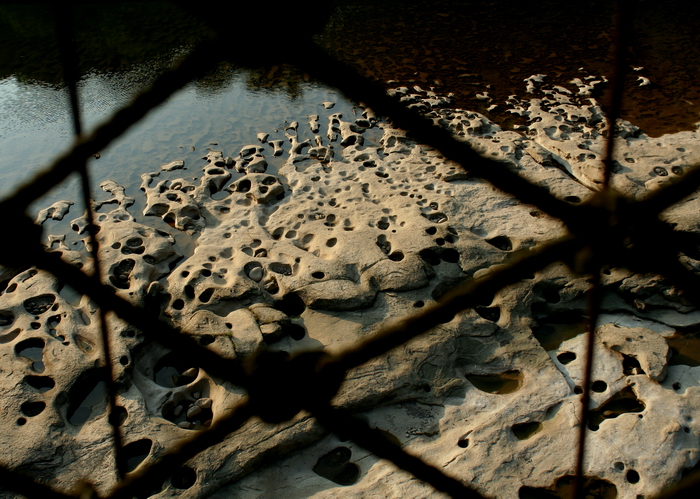
In any case, as Richard says, one of the best streams for viewing the teapot holes in Maokong is close to the gondola. It's worth a look when you are in the area.
At the end of a long series of wood steps we reached a grassy field at the bottom of the valley. A number of colorful swallowtail butterflies fluttered up and circled overtop. Maokong doesn't have big colonies of butterflies but it does have a nice variety of species and they are comfortable with people.
We crossed the stream on a small wooden bridge and then headed down. The trail ran close to the water for half a kilometre and then made a sweep to the left as it hugged a rather precipitous cliff wall. The steps were now cut into the stone and rather slippery on this humid day. We held on to the metal railing and inched our way down slowly. Katanya picked up Xian Cao (her three-legged dog) and carried him down.
Most of the group had now idea what to expect at the bottom so it was fun to watch their reaction when this popped up:

It's a small branch temple of the larger and more well known Zhinan Temple that overlooks Muzha (and is the penultimate stop on the gondola). I discovered it quite by accident about 10 years ago and have been coming ever since once or twice a year.
The temple is carved into the cave behind a 30m waterfall and you can walk into it, and get behind the falls, on the weekends and explore.
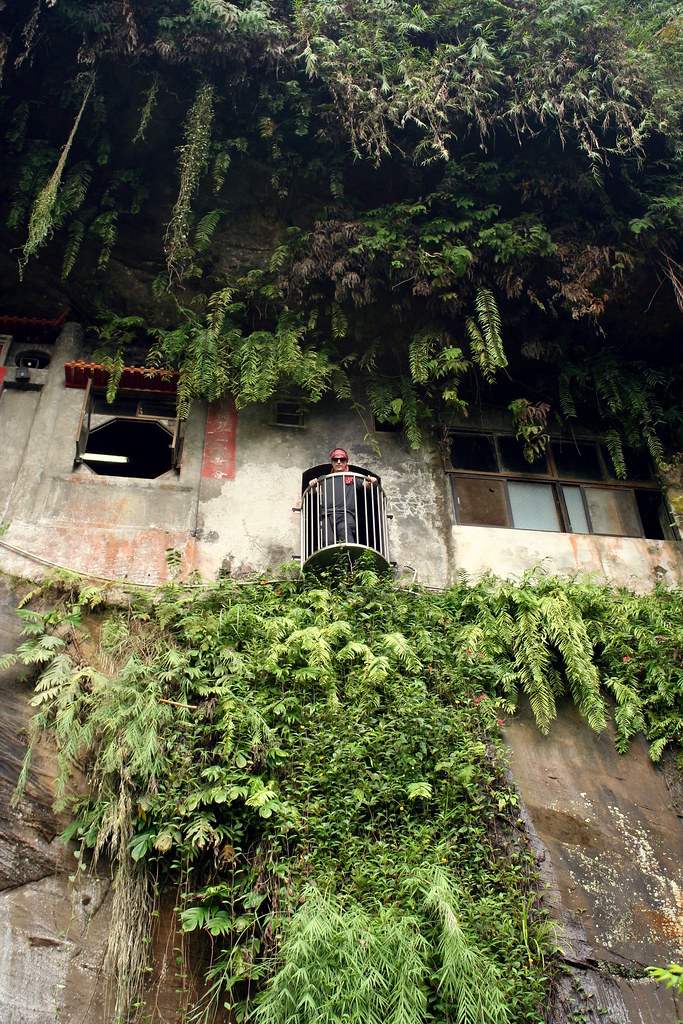
There's not so much to see inside though one wall has some interesting faded Buddhist script, and the caretakers are usually around offering tea to visitors. Sure enough that afternoon we were plied with cup after cup of Baozhong, a locally grown oolong. I had always thought Tieguanyin (Iron Guanyin) was grown in Maokong but the caretaker informed me that both are grown: Tieguanyin is planted on the other side of the ridge, closer to Taipei, while Baozhong is grown in the region closer toward Pinglin.
After lunch and tea we started back. At the bridge we continued upstream rather than crossing the bridge and returning the way we came. This is another favorite section of trail. Though Taipei sits just on the other side of the ridge, there is a palpable feeling that you have gotten away from it all. Or perhaps gotten back in time. The stream flows through a narrow but steep ravine. Some sections have manmade stone retaining walls and near the end an old rotted-out bridge crosses the junction of two small streams.
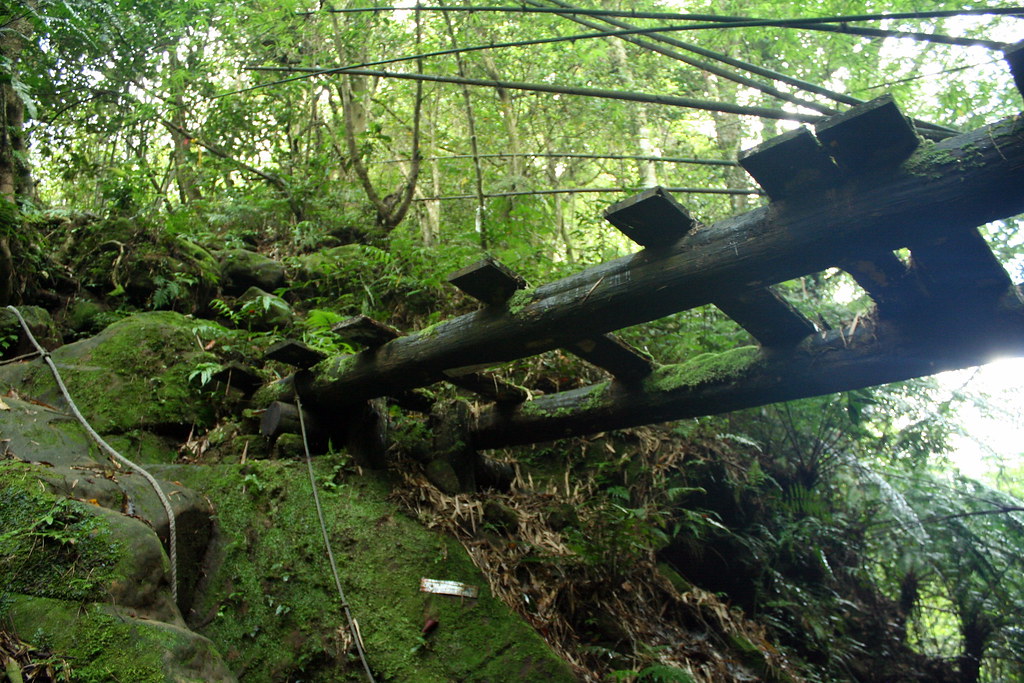
I love this spot though Xian Cao took some time to appreciate it.
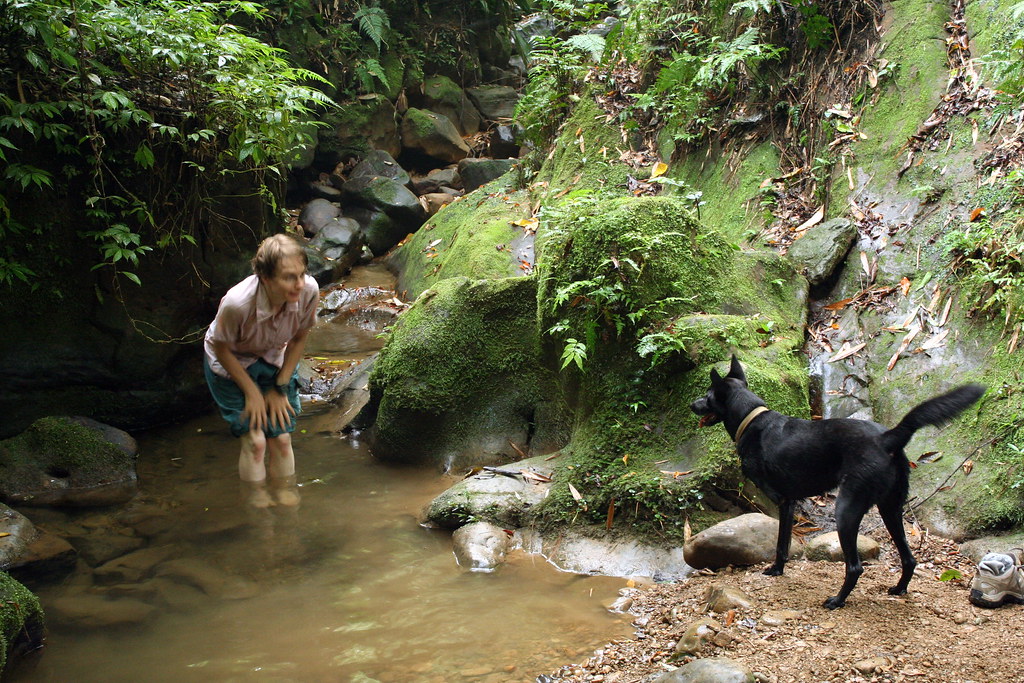
At the confluence (if it can be called that), we headed up the left stream and then began a fast ascent to the ridgeline. It's a 30-minute climb through a lush forest that very few hikers take. Lots of beautiful old bamboo stands left over.
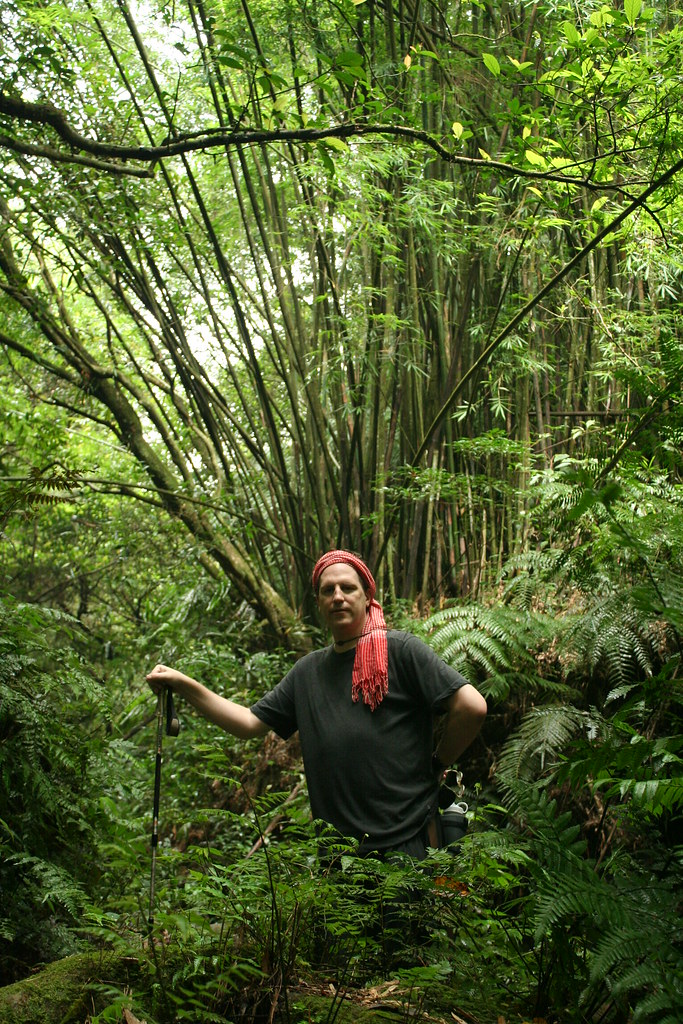
The stream is tiny here and flows through any even tinier canyon. It's perfect river tracing terrain for toddlers (Peter are you listening?).
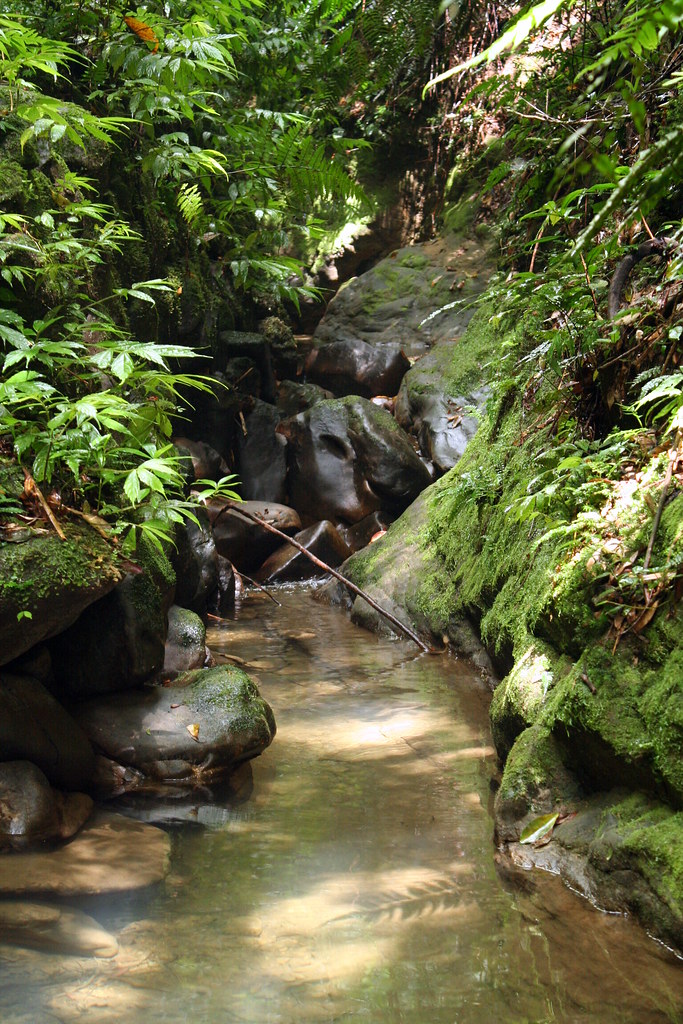
At the ridge, there is a wide clearing and a junction of trails. Straight down takes you to the Maoking gondola station and Sanxuan Temple where we began. To the right is a splendid 2.5 hour walk to Ergeshan, the highest mountain in the southern foothills that ring Taipei.
We went left. At first we strolled along the ridgetop through open fields. Taipei spread below us and on a clear day like this looks pretty attractive (in general I think the city looks best from the south). In one clearing we could look east to Ergeshan, the last of the rolling summits in this pic:

And then it was down the ridge along a narrow trail, hemmed in by ferns and a forest of machilus and acacia.
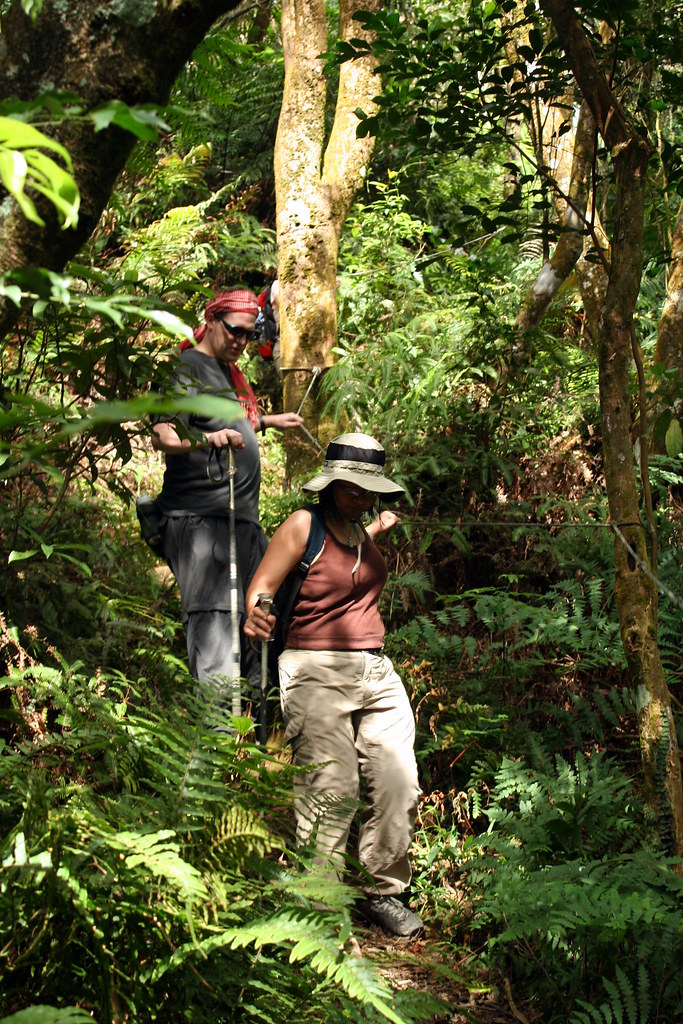
In one dense section of woodland, a pair of black bulbuls (an endemic sub-species) in the trees above warned us away with their terrible squawks. Beautiful if rather territorial creatures. From the birding in Taiwan website:
Later, Chris found this wonderful but deadly mushroom. Notice the slug speeding up the side?
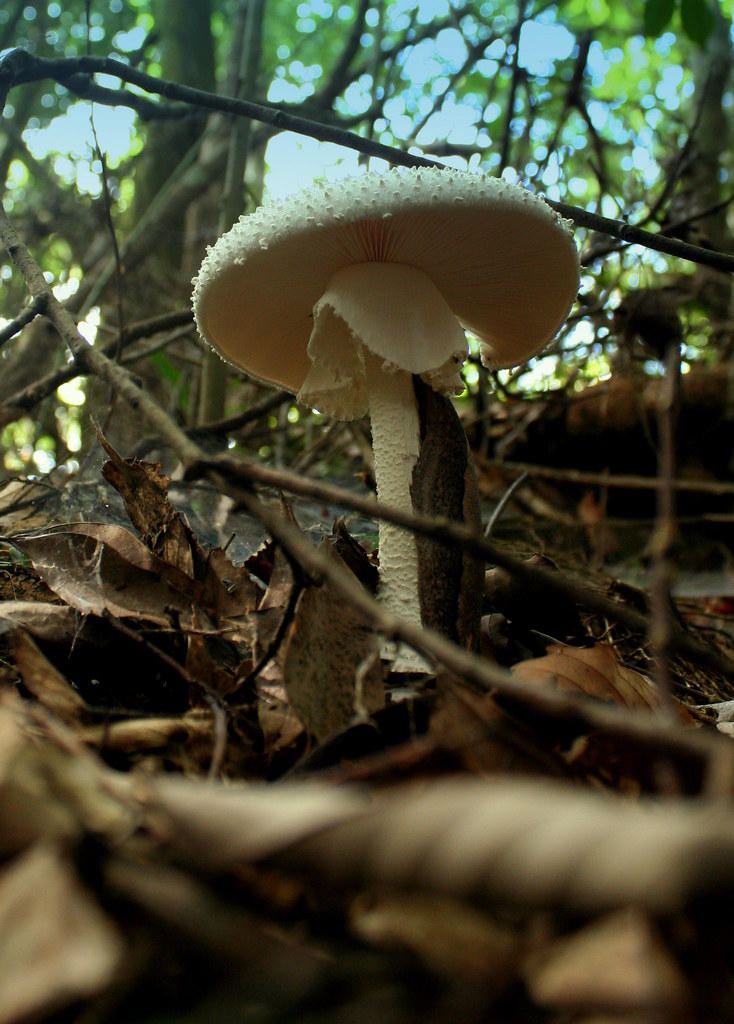
The trail eventually led us back to the lowest point of the ridgeline where we had stood a few hours earlier. We skipped back down to the road and on the way to the car (only 1km at this point) stopped in at Xiao Mu Wu (Little Wood House) one of our favorite restaurant-teahouses in Maokong.
We ate dinner and watched the sunset over Taipei.
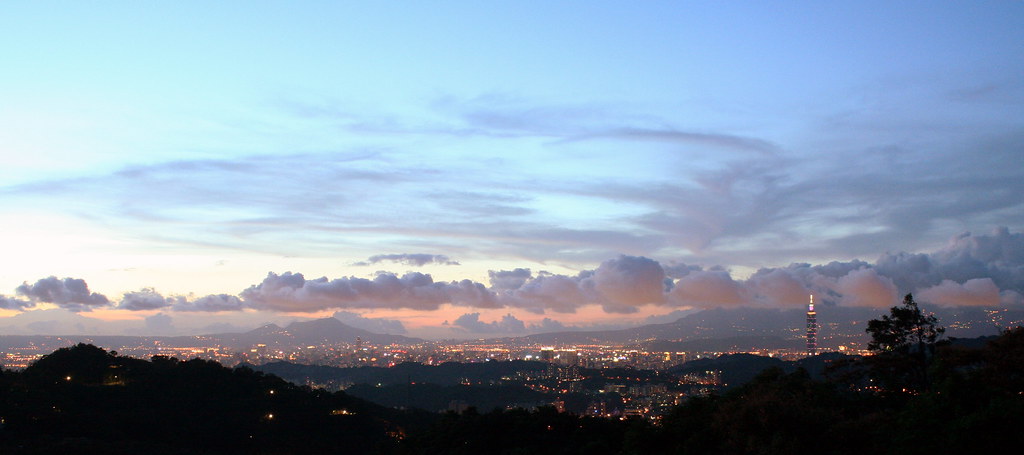
Practicalities:
When the gondola reopens, as it should by the end of 2009, this hike will once again be a natural for anyone looking to get out of the city for a few hours. Just get off the gondola at the last stop (Maokong) and cross the road. Look for a set of stairs kitty corner and follow them up, turning right about 150m along.
This is a hike for all seasons and weather conditions. I particularly love the area on a misty day.
As this is just a hop from my house, the Dutch can get a lift with me by car anytime they visit. Which I hope is soon.
For more on the name Maokong see this article from Tailingua.
Here's the name card for the restaurant.

Practicalities:
38 comments:
Would this be said farmhouse?
http://www.flickr.com/photos/katannya/4079934287/
[URL=http://s279.photobucket.com/albums/kk160/kagedogs/?action=view¤t=100_0289.jpg][IMG]http://i279.photobucket.com/albums/kk160/kagedogs/th_100_0289.jpg[/IMG][/URL]
Hmm, yeah, but the farmhouse looks like a tin shack from that angle. Didn't noticed they covered the brick. Well, that's the first thing I tear down when I move in.
Hmmm. Have the Dutch fallen from your grace? No special references anymore...? And today of all days, when Dennis and I have just been discussing doing the Annapurna Trek at some point in our lives, and inviting you along for it.
Hey, did I forget the Dutch? Impossible. Well, maybe this one time. Will fix right away.
Thanks Robert! I hope the Dutch visit soon too :) x
Isn't part of this hike what Richard calls Silver Stream Trail in his book?
I think I've been up to that waterfall temple (and was offered a nice cup of tea) but got there from the south. I took a bus from Xindian MRT station to the first hairpin on road No 9, then had to drag myself up an insanely long flight of stairs. Beautiful hike if you survive those...
I concure with what Balazs said: The stairs to get there are really long!
Thanks for great inspiration. I have found so much valuable info for my upcoming trip to Taiwan.
Countdown has begun - leaving in 3:21 hours!!!!
Taking my bike and my hiking boots with me and will see how fra around the island I get in the month that I have.
:-))
Grete, Denmark
Are you still in Taiwan? Is Pashan = '爬山'?
Yes,pashan = 爬山
Great post. But Lee Teng-hui was not mayor of Taipei in 1987! I wonder then who coordinated the rebranding of this wonderful part of Taipei?
beautiful, the picture of sunset.
Hi,
My name is Matt and I live down here in Hualien. I have been here for a while and I am in the process of opening an outdoor business leading trips into the mountains and rivers of Hualien. I was doing research and came accross your site. The site is great. I was wondering if you wanted to come down to Hualien for a trip. I'd love to chat with you about some of your expirences travelling around the Island and maybe take you up a pristine river or two while you were here. I am interested in trying to get the word out about just how beautiful the east coast really is. I always find that people from other countries just have no idea what this wonderful little country has to offer.
Anyways, great work on the blog!
-Matt
mematthopkins at hotmail .com
Really thanks to you share with us.
Hello Robert,
I saw your appreciation for the dutch so thought maybe you could help us.
My friend and I, two hikers from the Netherlands aka Holland, are trying to get a permit for hiking in the Yushan park.
Initially we asked a permit for the Japanese Occupation Era Trail but apparently large sections are closed due to landslides.
Therefore we asked a permit for the Southern Cross Highway Section 2 Trail or the Batongguan Historic Trail. We were told that these trails are only possible with a Taiwanese guide. We tried the Chinese Taipei Alpine Association but got no response yet.
Do you have any tips to arrange these permits or a native guide?
Kind regards,
Martijn and Ciske
martijnnaring@hotmail.com
Nice blog
i like it
wow good blog
Nice info
wow good web
I missed doing this kind of thing...
View this site for Best IT Support White Plains
is it a farmhouse?
You have a great blog. With the BloggerContest.com you are a candidate to win with your website or blog, promote your web page, win prizes and promotions. With the support of our sponsors via we organize our blog competition for the first time in 2017. You can learn more about participation from our website.
You can join, the applications are ongoing.
Web : http://www.bloggercontest.com
Mail : contact@bloggercontest.com
Pbx : +650694802050
Wow! Shoutout love! This is INCREDIBLY helpful, thank you guys!
Wow! This is incredible and the place was awesome. Hope to experience this adventure at Maokong soon. Love your article. Big thanks and keep posting.
Cheers!
budget lodge in sukhumvit
Not sure if you will see this comment, but I'd love to know where that waterfall temple is specifically. It looks beautiful, i'd love to check it out sometime. I've gone for a few hikes around maokong, but never stumbled across that area. Thanks!
Al Qur'an Keutamaan Doa Nino Nurmadi, S.Kom Nino Nurmadi, S.Kom Nino Nurmadi, S.Kom Nino Nurmadi, S.Kom Nino Nurmadi, S.Kom Nino Nurmadi, S.Kom Nino Nurmadi, S.KomCara Wudhu Nabi Muhammad Saw
Nice Blog
Industrial Water plant
RO Plant
Industrial RO Plant
Purified Water Generation System
Waste Water Treatment Plant
Awesome Blog
WE are Mineral Water Plant
Turnkey Mineral Water Project
Industrial RO Plant
RO System for Pharmaceutical
you have done a great job. I will definitely dig it and personally recommend to my friends. 파워볼
This is very interesting, You are a very skilled blogger. I've joined your rss feed and look forward to seeking more of your wonderful works. 토토사이트
I really like looking at and I believe this website got some really useful stuff on it! 온라인카지노
I know this site presents quality based content and other information,
is there any other website which gives these things in quality? 바카라사이트인포
Whats up are using WordPress for your blog platform? I’m new to the blog world but I’m trying to get started and set up my own. Do you require any coding expertise to make your own blog? Any help would be really appreciated!
https://www.safetotosite.pro
Thank you for sharing excellent informations. Hiking Gear List
Tengo muy poco capital para apostar, a diferencia de muchas personas que ganan mucho dinero. Pero ya no necesito trabajar cuando puedo ganar un solo día leyendo este artículo y sus enlaces que me llevan a ingresos ilimitados. En este enlace
شركة تنظيف بالرياض عمالة فلبينية شركة حور كلين للتنظيف في الرياض هي شركة متخصصة في تقديم خدمات التنظيف المنزلية والتجارية. تميز الشركة نفسها بتوفير عمالة فلبينية ماهرة ومدربة على أعلى مستوى من الكفاءة والاحترافية. تشمل خدمات حور كلين تنظيف المنازل، والمكاتب، والسجاد، والمفروشات، والنوافذ، بالإضافة إلى خدمات التعقيم والتنظيف العميق للمطابخ والحمامات. تلتزم الشركة باستخدام أفضل المنتجات والمعدات لضمان تحقيق أعلى معايير النظافة. بفضل التزامها بتقديم خدمات متميزة واهتمامها بالتفاصيل، اكتسبت حور كلين سمعة ممتازة في الرياض وجعلت من نفسها خيارًا مفضلاً للأسر والشركات التي تبحث عن بيئة نظيفة وصحية
Post a Comment